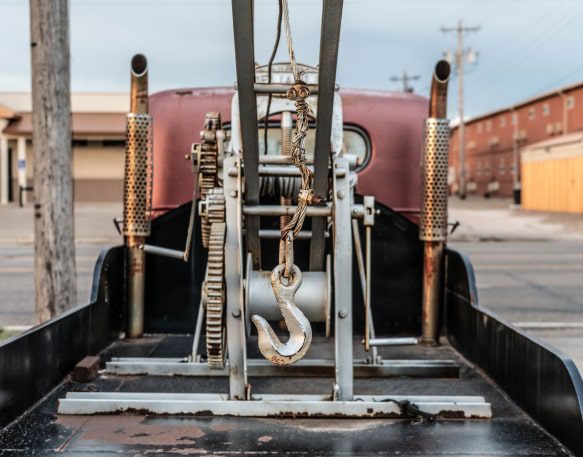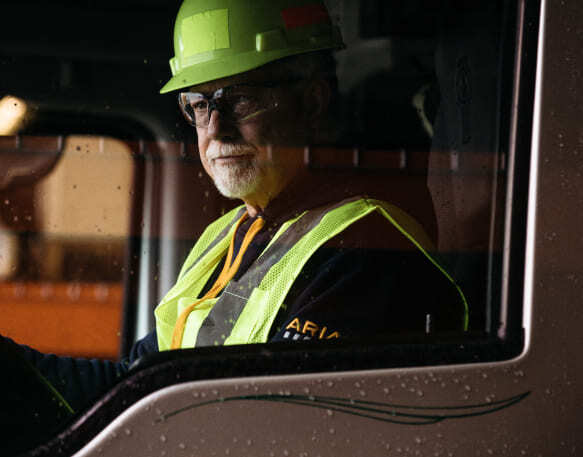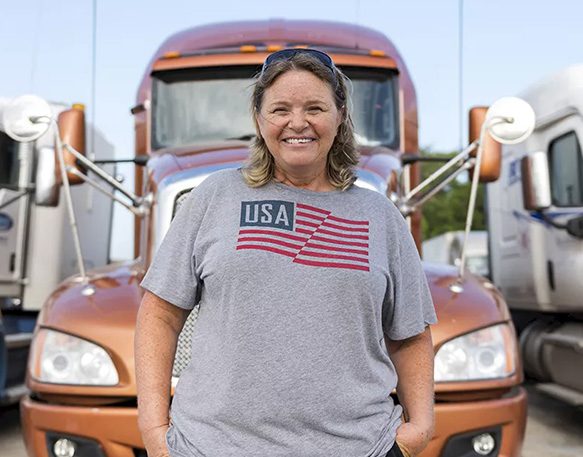Fear not. In this beginner’s guide to drop and hook trucking, we’ll answer all your questions so you can decide if it’s the right fit for you. We’ll cover key topics including:
- What is drop and hook trucking?
- How does drop and hook trucking work?
- The difference between drop and hook and live loads
- Who uses drop and hook
- The benefits and challenges of drop and hook
What is drop and hook trucking?
Drop and hook trucking occurs when a driver drops a full container or trailer at a facility and then hooks their tractor to a trailer from the same facility. In some cases, both trailers may be fully loaded, or a drop and hook driver may trade in an empty trailer for a pre-loaded trailer at the loading dock. Either way, this grab-and-go efficiency, which is a hallmark of drop and hook trucking, makes drop and hook highly appealing for both shippers and carriers. Shippers benefit from reduced transportation costs, while carriers can take advantage of potentially higher earnings since they can spend less time waiting around for trucks to be loaded and unloaded. Instead of handling the cargo, the process of drop and hook trucking is as simple as: drop, hook, and go.
If you’re starting to think drop and hook trucking seems too good to be true, that’s because sometimes it can be. You might show up to the dock and find the new trailer nowhere to be found. On larger sites, it’s possible that the cargo is inaccessible when you arrive. Either situation calls for facility workers to reposition the trailer to an accessible on-site location, inevitably slowing you down. And then, once it’s in place, hooking up to heavy, fully-loaded trailers is by no means a walk in the park.
Like most lines of trucking, drop and hook ultimately has its pros and cons. Drivers venturing into the drop and hook trucking business should weigh out the challenges and against potential upsides. We’ll get into both the benefits and the challenges of drop and hook trucking later in this article.
How does drop and hook trucking work?
At its best, drop and hook trucking can be very straightforward. The process begins with the driver arriving at the site and unhooking their full trailer. From there, the driver will hook up to the new trailer and be on their way. It’s that simple. At least, that’s the kind of ease and efficiency that drop and hook trucking is designed to deliver in theory. But in today’s increasingly volatile business climate, drop and hook trucking isn’t always as smooth as it’s drawn up to be.
There are a lot of reasons why drop and hook truckers may experience setbacks. Sometimes drivers turn up at a facility only to find the new trailer is stored offsite. In other cases, the new trailer may not be accessibly positioned or it may be stuck behind other lagging trailers. Any of these situations — which aren’t uncommon and require the driver to wait on-site for facility workers to hook up the full new trailer — produce slowdowns that generate negative knock-on consequences for drop and hook drivers.
Of course, with that being said, the wait times drop and hook drivers might fall victim to in any of those scenarios still pale in comparison to the average wait times drivers encounter with live loads. While live loads can involve drivers idly waiting for more than 3 hours at a facility, the average wait time for drop and hook drivers remains less than an hour even taking into account all those possible delays.
In short, drop and hook trucking can ultimately be a win-win for drivers and shippers alike. Drivers are attracted to the convenience and flexibility of a type of trucking that is inherently built to minimize downtime. At the same time, drop and hook lets shippers operate on their own terms to optimize operational efficiencies — preloading trailers as they see fit rather than having to adhere to a stricter live load schedule.
Differences between drop and hook freight and live loads
Drop and hook cargo should not be mistaken for live loads. Live loads in trucking refer to instances where the driver arrives at a facility, docks with a trailer, and waits for freight to be loaded or unloaded by other people.
Live loads usually necessitate greater coordination from the shipper’s logistics team relative to drop and hook trucking. Incoming and outcoming live loads often remain scheduled within specified appointment windows, where facility staff are available to load freight on and off trailers. A facility becomes susceptible to cargo bottlenecks and unintended added costs If supply chain breakdowns throw the schedule off course. Driver wait times and detention payouts (for the time the driver spends waiting at the facility) increase when warehouses that handle live loads suffer delays.
On the whole, drop and hook trucking affords greater flexibility to the various stakeholders involved along the freight journey compared to live loads. While basic scheduling and coordination remains necessary with drop and hook trucking, warehouses can maintain a much wider window to load and unload new trailers, meaning a single delay won’t have major repercussions that slow the whole site down. The best drop and hook facilities operate like well-oiled machines, ensuring that drivers are in and out as quickly as possible, reducing detention fees for shippers and increasing the time carriers can spend on the road.
Why is drop and hook so popular?
Drop and hook trucking has emerged into a booming business in recent years — and it shows no signs of slowing down any time soon. Shippers continue to value competitive price points and reliable capacity above all else when seeking trucking services. In an economy where expedited freight remains in high demand, there’s no doubt that demand for drop and hook trucking will also remain high with drop and hook drivers filling the void of capacity crunches that plague supply chain networks and alleviating the mounting pressure on shippers to stay on schedule.
Some specific reasons why drop and hook trucking is so appealing to shippers includes desire to:
- Simplify floor-loaded, loose freight: Loose cartons are a necessary part of trucking in many cases, but they usually take more time to load and unload than containers might. As a result, instead of taking the live load route, most shippers find it is more efficient to pre-load this kind of cargo into a drop and hook trailer to avoid high detention fees.
- Save money: Any live load that gets delayed or takes more time than budgeted to load or unload can back up the whole warehouse. When outgoing deliveries become delayed, transportation costs rise for shippers as they’re forced to pay detention fees. Drop and hook services are typically more efficient and cost-effective for shippers, making them a popular choice.
- Increase flexibility: The rigidity of live load scheduling doesn’t lend itself to warehouses that find themselves short of staffers or bogged down with overdue cargo. Drop and hook trucking offers more flexibility, making it a better option for facilities that experience situations where they regularly have too much inventory or not enough workers available.
- Move high volume freight easily: Because live loads are restricted to a more narrow scheduling window, they can be limiting for high volume shippers. Drop and hook trucking makes moving high volume freight much simpler, which is why it’s at the heart of the high volume freight business.
Despite its many points of appeal, drop and hook trucking is not above limits. If a warehouse doesn’t have enough (i.e. at least two) trailers or has insufficient parking space, regardless of how backed up the facility might be, it remains ill-equipped for drop and hook trucking.
The benefits and challenges of drop and hook
If you’re considering going into drop and hook trucking, it’s good to consider the pros and cons it offers to determine if it’s the right fit for you. Here are some common benefits and challenges to keep in mind.
Benefits of drop and hook trucking:
- No-Touch Freight: Some warehouses want truckers to partake in the loading and unloading phase, but established facilities often have a team to handle loading duties. Rather than idling around a dock for hours until the loading has finished, part of the beauty of drop and hook trucking is that drivers can bypass the load and unload process altogether.
- Speedy Deliveries: More time spent on the road is another big advantage of skipping the loading process in drop and hook trucking. Less waiting around and faster deliveries mean drop and hook drivers spend more time on the road. More time on the road means more mileage (within the legal limits of course). More mileage means more pay and greater profits!
- Flexible Scheduling: As we’ve mentioned, the relative ease of scheduling is an increasingly valuable piece of drop and hook trucking for all involved stakeholders. Drop and hook trucking allows shippers to conveniently pre-load new trailers as their schedules permit, while drivers benefit from similarly convenient pickups and dropoffs within larger time windows.
- Unique Freight Opportunities: High-volume facilities and backed-up shippers shy away from live loads because they often involve higher shipping costs and the possibility of detention payouts. If you’re interested in carrying high-volume freight or working with shippers who might avoid live loads, drop and hook could be a great fit.
Challenges of drop and hook trucking:
- Backed Up Trailers: We’ve explained the powerful domino effect delays to a single load can have with live loads. While a single load may have less of an immediate impact in a drop and hook scenario, delays can still happen. The result is that drop and hook drivers may arrive on-site only to find the new trailer is inaccessible or unavailable, leaving them little recourse beyond waiting.
- Trailer Quality: Drop and hook trucking is not for everyone — especially those who remain wedded to their own equipment. Remember: the driver trades in one trailer for another for each new drop and hook, meaning trailer quality varies with each new drop and hook job. Some risk-averse drivers prefer to stick with their own tried and tested equipment rather than getting new equipment on each load.
- Compliance Responsibilities: It’s ultimately up to drivers to make sure any equipment they use complies with all enforceable guidelines no matter whether they’ve been using that equipment for their whole careers or they just got it that day. Those same driver responsibilities extend to weight restrictions on trailers. If a shipper ends up excessively packing a trailer, the drop and hook driver will have to return to the warehouse to offload items, which can waste time.
- Hook-Up Problems: It’s no small task to hook up a fully loaded trailer. It takes skill and, the heavier the trailer, the harder it is to maneuver alone. With many facilities still facing limited resources and manpower, there is an opportunity cost for each additional worker that gets pulled in to assist with the hook-up process, meaning drivers may be stuck trying to perform the process alone.
Dive into drop and hook trucking with DAT
Now that you know what all the drop and hook fuss is about, it’s up to you to determine whether drop and hook freight is right for your business. If you do decide to steer your fleet into the drop and hook space, there’s only one place to start.
DAT is the premier one-stop-shop for all of your drop and hook trucking needs. Why? Because DAT is all about delivering premier services to carriers. With hundreds of thousands of new loads posted daily, the DAT load board is the best place for drop and hook carriers to find freight that keeps their fleet on the road to success. And that’s not all. Whether you’re just starting out in the trucking industry, or you’re long-established, DAT has everything you need to help your business succeed.
To learn more about DAT’s drop and hook trucking tools and services and to join the largest freight network in the industry, get in touch with the DAT team today!
Find drop and hook loads with the DAT load board!
Drop and hook trucking is popular with good reason, but you can’t experience the speedy, flexible, no-touch experience that comes with drop and hook trucking if you can’t find loads. That’s where the DAT load board comes in.
Start finding drop and hook loads with the DAT load board today!




